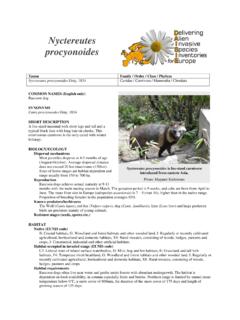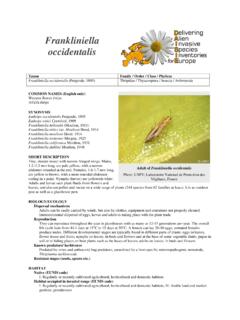Transcription of Halophila stipulacea - DAISIE
1 Halophila stipulacea Taxon Family / Order / Class / Phylum Halophila stipulacea (Forsskal, 1775) Ascherson Hydrocharitaceae / Hydrocharitales / Liliopsida / Magnoliophyta COMMON NAMES (English only) Halophila seagrass SYNONYMS None. SHORT DESCRIPTION A euryhaline marine angiosperm (seagrass). Plants are dioecious with male and female flowers produced at each leaf node. Rhizomes are creeping, branched and fleshy, and roots appear solitary at each node of the rhizome, unbranched and thick with dense soft root hairs. Pairs of leaves are distributed on petioles along a rhizome, rooted in the sand.
2 Leaves from 3 - 8 mm wide, obovate, not narrowing at base, thin and hairy; margin spinulose. Petiole 3 - 15 mm long. BIOLOGY/ECOLOGY Dispersal mechanisms Current and vessel-borne plant fragments, fruits. Reproduction Flowers are solitary, axillary covered by spathes. It disperses strings of four reniform trinucleate pollen grains contained in a mucilaginous moniliform tube. In India, female flowers and fruits are noticed from February to April. In the Mediterranean the main flowering season occurs in July-August, with fruits ripening in September.
3 Known predators/herbivores Grazing invertebrates and fish. Resistant stages (seeds, spores etc.) None. HABITAT Native (EUNIS code) A4: Sublittoral sediments. Marine sublittoral soft, grows in sheltered localities as isolated patches, on muddy bottom and coral rubble. Habitat occupied in invaded range (EUNIS code) A4: Sublittoral sediments. Marine, sandy and muddy bottoms, intertidal to 65 m, but mainly at depth of 30-45 m, mostly in harbours, or in their vicinity. Habitat requirements Unknown. DISTRIBUTION Native range Western Indian Ocean: Red Sea and East Africa, Persian Gulf, to southwestern coast of India.
4 Known Introduced Range Mediterranean: Levantine Sea, southern Aegean, Zakynthos I. , Greece, Malta, Sicily, Tunisia; in ports and near ports. Halophila stipulacea Photo: Baki Yokes Trend The first record in the Mediterranean was collected in 1894 in Rhodos Island, Greece. In 1923 its detached leaves were found in the Cyclades and in Piraeus, and soon after meadows were found off Faliron, Piraeus and Aegina in the Saronic Gulf, the Cyclades and the Sporades. By 1963 it reached the Gulf of Pagassai, northwestern Aegean Sea. In 1955 it was collected off Crete, and in 2001 it was found in a small harbour in Zakynthos I.
5 , on the Ionian coast of Greece. In 1941 it was recorded off Port Said, Egypt, at the northern Terminal of the Suez Canal, and in 1958, off Marsa Matrukh Harbour. In 1966 it was collected off Lebanon, and in 1967 extensive meadows were found off Cyprus. In 1970 it was found in Marsaxlokk, Malta, in 1990 off the northern coast of Sicily, Italy, and in 2003, in the Gulf of Gabes, Tunisia. It forms extensive and stable meadows off Sicily, characterized by high density values ( shoots/m2) and an abundant and diversified fauna. MAP (European distribution) Legend Known in country Known in CGRS square Known in sea INTRODUCTION PATHWAY It entered the Mediterranean through the Suez Canal.
6 The Aegean populations may have originated from fragments carried by Greek fishing boats, and secondary spread is likely due to ship transport. IMPACT Ecosystem Impact Out-competing the native Mediterranean seagrasses. It can induce changes in the sublittoral communities. A comparison between the associated algal assemblages of an invaded meadow and two contiguous meadows dominated by Posidonia oceanica and Cymodicea nodosa revealed significant differences in species composition. Health and Social Impact Unknown. Economic Impact Unknown.
7 MANAGEMENT Prevention Erect a salinity barrier in the Suez Canal in order to reduce the number of Red Sea aliens arriving in the Mediterranean. Mechanical Unknown. Chemical Unknown. Biological Unknown. REFERENCES Lipkin Y (1975a) Halophila stipulacea , a review of successful immigration. Aquatic Botany 1: 203-215 Di Martino V, Blundo MC, Tita G (2006) The Mediterranean introduced seagrass Halophila stipulacea in eastern Sicily (Italy): temporal variation of the associated algal assemblage. Vie et Mileu 56(3): 223-230 Tsirika A, Haritonidis S (2005) A survey of the benthic flora in the National Marine Park of Zakynthos (Greece), Botanica Marina 48: 38-45 OTHER REFERENCES Alongi G (1993) La macroflora epifita delle foglie di Halophila stipulacea (Forssk.)
8 Aschers. del Porto di Catania. Biologia Marina Mediterranea 1: 287-288 Lipkin Y (1975b) Halophila stipulacea in Cyprus and Rhodes, 1967-1970. Aquatic Botany 1: 309-320 Missaoui H, Mahjoub S, Chalghaf M (2003) On the presence of the marine phanerogam Halophila stipulacea (Forsskal) in the gulf of Gabes. Bulletin de l Institut National des Sciences et Technologies de la Mer 30: 111-114 Procaccini G, Acunto S, Fam P, Maltagliati F (1999) Structural, morphological and genetic variability in Halophila stipulacea (Hydrocharitaceae) populations in the western Mediterranean.
9 Marine Biology 135(1): 181-189 Rindi F, Maltagliati F, Rossi F, Acunto S, Cinelli F (1999) Algal flora associated with a Halophila stipulacea (Forssk l) Ascherson (Hydrocharitaceae, Helobiae) stand in the western Mediterranean. Oceanologica Acta 22(4): 421-429 Author: B. S. Galil Date Last Modified: November 5th, 2006



